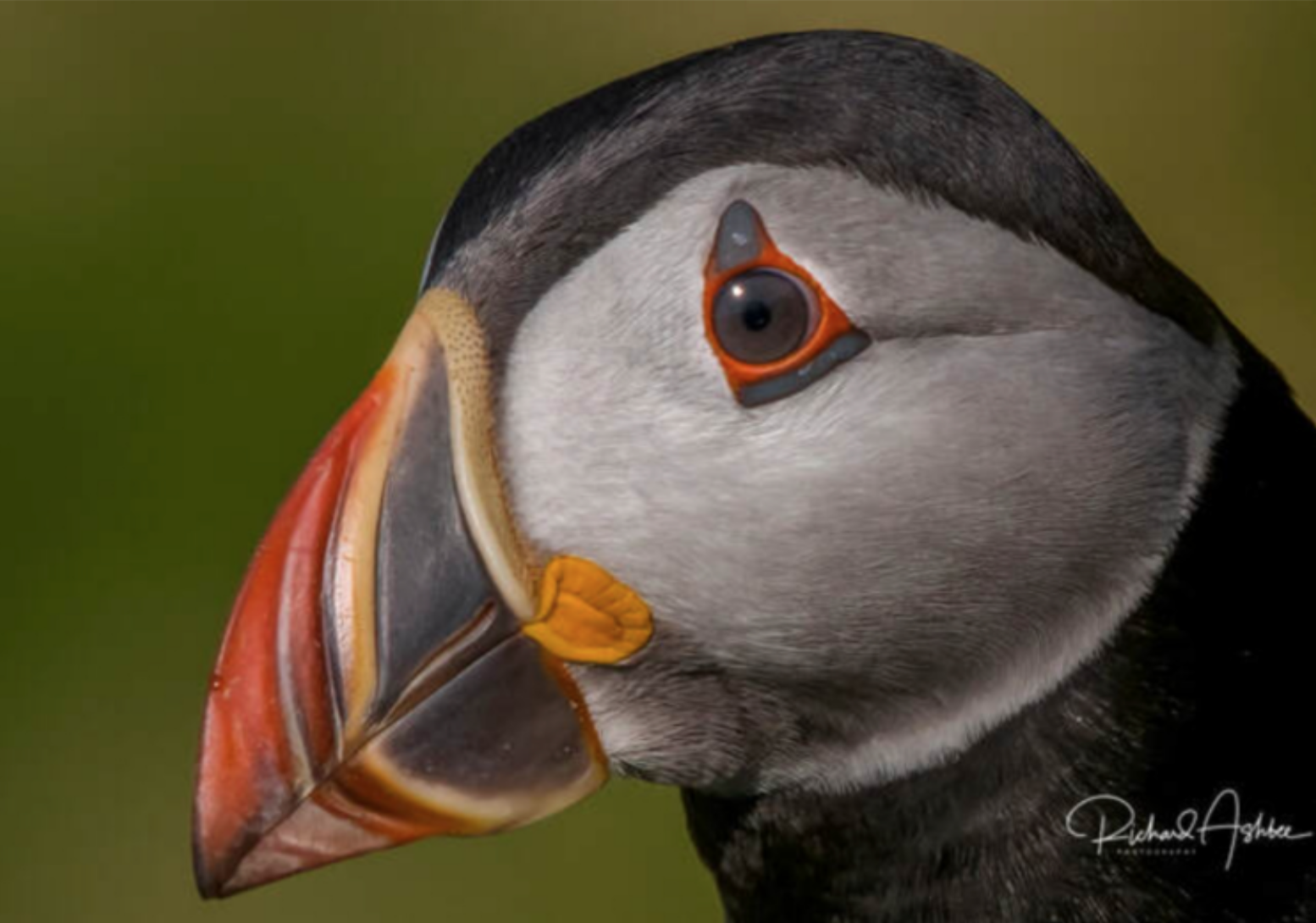Book reviews - Best Days with Shetland’s Birds and Shetland Puffin
It’s hard to write a positive narrative of Shetland’s summer so far. Avian flu is devastating our breeding seabird colonies and, as I write, we’re enduring another spell of bad weather – low-lying fog, chill wind and drizzle – in all, there haven’t been many positives to write about this summer.
Yet, as I stood last night, at midnight, watching the incredible frenzy of storm petrels returning to their breeding grounds within the broch walls at Mousa, I realised there is still much to celebrate and be thankful for.
This may be a bad summer for many of our breeding birds, but, with time, we can only hope that they’ll make a full recovery and bounce back once more to their glorious best; providing us with endless hours of happiness as we observe them busily narrating their lives around our outstanding and nationally important breeding grounds.
Instead of maudlin, I decided to spend an otherwise dreich Sunday with a couple of new bird books, including Best Days with Shetland’s Birds, the latest wildlife-inspired publication from the Shetland Times and edited by Andrew Harrop and Rebecca Nason, and Richard Ashbee’s photographic guide, Shetland Puffin.
I spend much of my days in summer interpreting Shetland’s wildlife to guests, so I was looking forward to sitting down and furnishing myself with some more birdy facts and anecdotes to share on tours.
Atlantic puffin. Photo: Richard Ashbee
Best Days with Shetland’s Birds
Edited by Andrew Harrop & Rebecca Nason
The Shetland Times (2022)
£17.99
Shetland Puffin
Richard Ashbee
(self-published by author)
email: shetpuffinbook@gmail.com to order
£14 (collected in Shetland) or £4.75 p&p (UK), will post anywhere in the world
Best Days with Shetland’s Birds
Edited by Andrew Harrop & Rebecca Nason
Best Days with Shetland’s Birds
boasts a beautifully designed and illustrated cover by the talented Shetland-based artist Howard Towll and promised, from the get-go, a fun, lighthearted and informative guide to Shetland’s birds – just the ticket following weeks of bad news bird stories.
To quote Ann Cleeves’ foreword:
“This is no dry examination of facts or statistics. It helps us understand the joy to be found in the natural world. These are the stories told and retold, while sheltering inside during westerly gales and horizontal rain.”
Diving in, I began with Mike Pennington’s memories of a March walk to Hermaness in 1990. I was struck by what he said about the great skua – particularly after seeing how much they were struggling at Hermaness only last week on tour. Mike noted that:
“Bonxies are not popular birds – hanging around lambing yows and nesting puffins endear them to neither crofter nor tourist … It is strange how lions or orcas are hailed as magnificent predators, yet bonxies are typified as cruel bullies.”
As a non-birder, it was interesting to gain an insight into how much of a thrill birders get – particularly during the spring and autumn migrations – as they tick off rare migrants.
My favourite accounts were those of Sheila Gear, who recalls summers counting birds as a child in Foula and, from Fetlar, recollections from Dennis Coutts about the snowy owls and Malcie Smith’s tales of tracking the migratory routes of the incredible red-necked phalaropes who travel as far as Peru to overwinter from their summer home on the Mires of Funzie.
I enjoyed learning more about storm petrels from Will Miles, particularly as I spend so many days – and nights – of summer with thealamooties (storm petrels) in Mousa.
Arctic tern, or tirrick, under the midsummer sun with Foula in the background
Stark reminders
Although upbeat and positive, the book contains some stark reminders of how much our bird populations have changed in recent years – particularly for many of our summer seabirds.
For example, Roger Riddington reminds us that, although numbers are up slightly again, in 1992, Fair Isle had 18,159 breeding pairs of kittiwakes and 109 pairs of Arctic skuas compared to the 859 and 28 pairs found in the island surveys of 2015 and 2019.
Our natural world is changing immeasurably, and with every passing year, we’re losing much of the richness that was once enjoyed around the isles. Sheila Gear’s poignant chapter of birding in Foula offers a worrying reminder of how much we’ve lost. She says:
“The island’s nights [now] are silent. Corncrakes and shearwaters are long gone. The Arctic skuas have retreated to a small remnant group, hanging on to survival within the protection of the airstrip. You can count the puffins by the hundred not the thousand. Drop all the stones in Foula off Waster Hoevda and not hit a kittiwake. And the gannets? They nest on the ledges above the Bight of the Scrudhurdins where, once upon a time, we spent many a happy hour counting guillemots.”
My tirrick tattoo, a reminder that these birds that represent the sound of a summer childhood in Shetland, is a call that, I worry, my grandbairns may never hear.
Some of the birds encountered in the book – the snowy owl, the corncrake and the white-tailed eagle – no longer breed here, yet others, like the fulmar and gannet, are relative newcomers to the islands, do exceedingly well here.
Who knows what the next 100 years will bring, but for me, and any other native or visitor to Shetland, we will continue to take pleasure and delight in the natural world. Best Days with Shetland’s Birds has inspired me to invest in that pair of ‘good’ binoculars and head out – maybe to Rory’s patch of westside turf – to start my own ‘list’, ticking off the birds as I go.
Shetland Puffin
by Richard Ashbee
Atlantic puffin carrying nest material. Photo: Richard Ashbee
Who doesn’t love a puffin? Known locally as the Tammie Norrie, as a tour guide, I understand that these charismatic little birds are top of the list for most visitors to the isles.
During conversations with guests and as the frequent topic of email enquiries, I’m usually always asked – ‘Will I see puffins?’, followed closely by, ‘Where is the best place to see them?’
Richard Ashbee, the author of Shetland Puffin, is a photographer who, as well as teaching people how to photograph nature and use their camera, has also had a keen interest in documenting the wildlife of the islands over the past three decades.
This book is a photographic guide to Shetland’s puffins and aims to enhance the visitor experience when viewing a puffin colony.
But, before we talk about the book – let’s get the big questions dealt with!
Atlantic puffin. Photo: Richard Ashbee
Atlantic puffin. Photo: Richard Ashbee
Where to find puffins in Shetland
This one is pretty simple – the most southerly point of Shetland, Sumburgh Head, and the most northerly point, Hermaness in Unst, are the best places to view puffins. There are smaller colonies dotted across the isles, colonies on the outlying islands of Fair Isle and Foula, and the uninhabited island of Noss.
When can I see puffins?
Puffins come ashore to breed and lay an egg, so they are on land during the summer breeding season from mid-April to mid-August. It’s best to view puffins in the early morning or early evening as they tend to spend their days at sea fishing.
And a couple of facts:
Puffins are part of the auk family
Puffins, as well as common guillemots, razorbills, and black guillemots, are all part of the auk family that are found to breed in Shetland.
Baby puffins are known as ‘pufflings’
A puffin will lay a single egg in an underground burrow on the top of the cliffs, rearing a single chick, known as a puffling, that resembles a powder puff!
I think that perhaps my favourite photos in the book are those of the pufflings – they’re not visually attractive in the same way that the adult puffins are, but as these young birds spend most of their time in burrows before heading out to sea, I haven’t seen them very often.
Atlantic puffin. Photo: Richard Ashbee
The book:
Despite being a beautiful book with stunning photography, Richard doesn’t skirt around the difficult truth that, as with other species, numbers have been in a sharp decline in recent years, with an almost 80 per cent decline in numbers in Foula between 2000 and 2015.
He also raises difficult questions about what impact any offshore wind development will have on our puffin populations in the future as wind technology develops further.
Shetland’s breeding seabird populations have struggled in recent years – particularly those, like the puffin, that depend on a diet of sandeels. Our seabird colonies are fantastic indicators of the health of our seas and are amongst the first species to feel the effects of global warming.
This book is visually appealing and is as much about your photography as the birds. It is illustrated with some incredible puffin photography, showing them feeding, nesting, and dressed in their elusive and muted winter plumage.
It’s the perfect coffee table compendium that you can pick up, flick through and soak in a few puffin facts. It’s colourful, glossy and contains all the beauty of summer in Shetland.
This book is a fantastic guide to Shetland’s breeding puffins, with information about when and where to see puffins, the numbers that breed here, their breeding habits, what they eat, where they go in winter and what they look and act like on land.
The biggest surprise I got when reading this was the puffin recipe at the end of the book – but before anyone thinks we’re all puffin munchers here, it’s an Icelandic recipe. It has been included in a discussion that Shetlanders haven’t eaten puffins since the 19th century (although they were hunted in Foula until the 1950s).
All in all, this is a delightful book to read and contains lots of interesting and hard-hitting facts about one of our favourite summer seabirds.
Gannets at Noss National Nature Reserve
Until next time,















